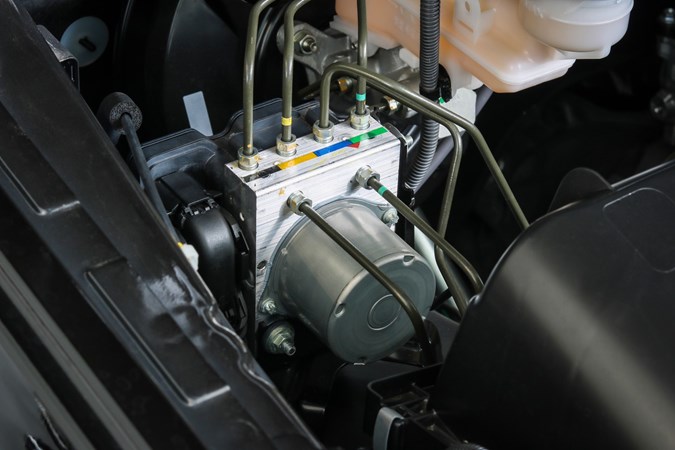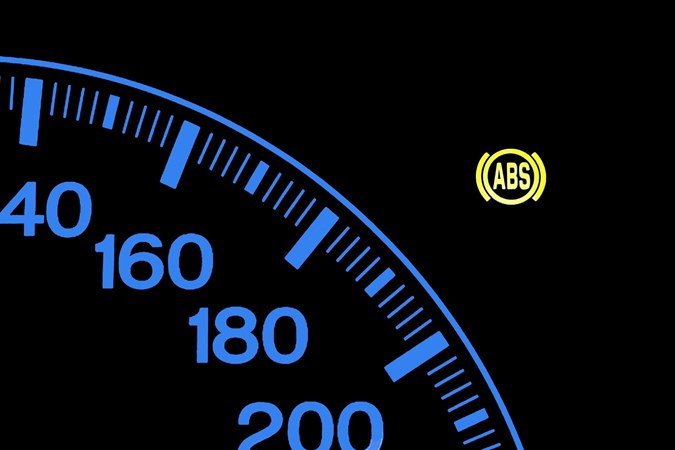An anti-lock braking system – usually known simply as ABS – is a crucial safety feature found on the vast majority of new cars. As the name suggests, it prevents a car’s wheels locking while braking, particularly in an emergency stop, shortening the distance it takes to stop and potentially avoiding an accident. It also allows you to maintain control and steer round any obstacles.
In this guide, we’re going to look at exactly what ABS is, how it works and, importantly, when it works. But first, let’s go over how to do an emergency stop in a car that doesn’t have ABS.
How to do an emergency stop without ABS
A car’s wheels lock while braking when there’s too much pressure going through the hydraulic system that controls the brakes. To stop the wheels locking, you need to vary the pressure in the system.
In a car without ABS, you do that by pumping the brake pedal – a technique known as cadence braking. In most cases, you should be able to feel, hear or even just intuit the moment the wheels are about to lock. At that point, release the pressure on the brake pedal – without taking your foot completely off – then immediately press it back down again. You may need to do that several times before the car comes to a halt. If you’re stopping from high speed, press the brake pedal all the way down and start pumping straight away – don’t wait for the wheels to lock first.

The idea is to keep the wheels turning so the car doesn’t skid out of control. You can’t steer during a skid, either, but the front wheels could turn of their own accord. Incidentally, it’s usually the front wheels that lock because they’re the ones carrying the most weight.
So how does ABS work?
ABS applies the principle of varying the pressure in the car’s braking system during an emergency stop but does so electronically. All the driver has to do is stamp on the brake pedal as hard as they can.
Speed sensors in the car’s wheel hubs detect when rapid deceleration – heavy braking – occurs. The ABS controller rapidly releases then reapplies the braking pressure as many times as needed until the car comes to a stop. Some systems can apply and release the brakes as many as 15 times per second. As with cadence braking, the idea is to keep the wheels turning which maximises the grip needed to stop quickly and allows the driver to steer around any obstacles.
When ABS is doing its thing, you’ll feel a bit of juddering through the brake pedal. Under some circumstances, that ‘kickback’ can actually limit how far you can press the pedal and give a feeling a bit like stepping on gravel in your socks. But we’ll come back to that in a bit.

ABS works with other systems, as well
There are many other safety systems in a car that employ anti-locking braking among the measures they take to keep you safe on the road. Traction control detects if a wheel starts to spin; if it does, some cars use the ABS to rapidly apply and release the brakes to slow the wheel down and stop the spinning.
Electronic stability control detects if the car is sliding out of control at the front or back end during cornering and uses the ABS to bring everything back under control. And ABS is crucial to autonomous emergency braking, which automatically applies every last ounce of the car’s braking force if it detects an accident is about to happen. Without ABS, the wheels would lock immediately.
Is it safe to drive a car with the ABS warning light on?
All cars with ABS have a warning light in the instrument cluster that indicates if there’s a problem with the system. You’ll also see the light when you start the car, but it should go out almost immediately. If the light stays on or reappears, you need to get the problem checked out as soon as possible. It’s usually just a failed sensor – though they can cost many hundreds of pounds to replace.
That can make it tempting to not bother, however the ABS warning light being on will cause your car to fail its MOT. More importantly, non-functioning ABS on one wheel can unbalance the system on the other wheels, potentially creating a dangerous situation when you least need it.

There are times ABS isn’t especially helpful
We mentioned earlier that, under extreme circumstances, the ‘kickback’ you feel through the brake pedal as ABS works away can feel like stepping on gravel, and even limit how far you can press the brake pedal. That’s usually caused by extremely slippery surfaces.
Exceptionally wet roads, mud and particularly ice can really confuse ABS, as there’s very little – or even no – grip, which ABS needs to work effectively. Even a small amount of brake pressure can cause the wheels to lock and the ABS controller struggles to make sense of the situation.
It’s an unfortunate, unavoidable side effect of how ABS works, but you can improve matters by fitting your car with winter tyres that provide more grip on ice. If you feel strong kickback, don’t try to fight it by pressing harder on the pedal and absolutely don’t take your foot off it. Just keep moderate pressure applied and let the ABS sort itself out.
Which cars have ABS?
ABS has been legally required on the vast majority of new cars sold in the UK since 2004 – only a few low-volume specials such as the Caterham Seven are exempt. The system was developed for aircraft; the first car to have it was the 1966 Jensen FF. By the 1980s it was included in the standard features of many high-end cars, and it filtered down to more affordable models throughout the 1990s. When ABS was made a legal requirement, it had been added to all but the most basic cars anyway.
Looking for more jargon-busting motoring meanings? Head over to our Parkers Car Glossary page and take a look at our other definitions
Just so you know, we may receive a commission or other compensation from the links on this website - read why you should trust us.








